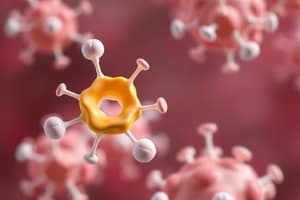Podcast
Questions and Answers
Which of the following first generation antihistamines is typically associated with the least amount of sedation?
Which of the following first generation antihistamines is typically associated with the least amount of sedation?
- Meclizine
- Diphenhydramine
- Doxylamine
- Brompheniramine (correct)
What is the primary mechanism through which first generation antihistamines prevent motion sickness?
What is the primary mechanism through which first generation antihistamines prevent motion sickness?
- Activating M1 receptors in the gastrointestinal tract
- Inhibiting chemoreceptors in the vomiting center (correct)
- Stimulating serotonin receptors in the vestibular apparatus
- Blocking H1 receptors in the thalamus
Which first generation antihistamine is approved for use in pregnancy when administered with pyridoxine (Vitamin B6)?
Which first generation antihistamine is approved for use in pregnancy when administered with pyridoxine (Vitamin B6)?
- Dimenhydrinate
- Diphenhydramine
- Meclizine
- Doxylamine (correct)
When recommending antihistamines for a patient prone to motion sickness, which of the following is the most suitable option?
When recommending antihistamines for a patient prone to motion sickness, which of the following is the most suitable option?
Which of the following first generation antihistamines is most highly sedating?
Which of the following first generation antihistamines is most highly sedating?
What distinguishes first generation antihistamines from second generation antihistamines in terms of their pharmacological effects?
What distinguishes first generation antihistamines from second generation antihistamines in terms of their pharmacological effects?
Which first generation antihistamine has been noted for its mild sedating properties and is often used less frequently?
Which first generation antihistamine has been noted for its mild sedating properties and is often used less frequently?
Which central nervous system structure is primarily affected by the action of first generation antihistamines in the context of nausea and vomiting?
Which central nervous system structure is primarily affected by the action of first generation antihistamines in the context of nausea and vomiting?
Which antihistamine is specifically approved by the FDA for the prevention of nausea and vomiting?
Which antihistamine is specifically approved by the FDA for the prevention of nausea and vomiting?
At what maximum dosage can children aged 2-5 years safely take Dimenhydrinate in a day?
At what maximum dosage can children aged 2-5 years safely take Dimenhydrinate in a day?
How many minutes prior to travel should adults and children over 12 years of age take their first dose of antihistamine like Dimenhydrinate?
How many minutes prior to travel should adults and children over 12 years of age take their first dose of antihistamine like Dimenhydrinate?
What is the primary mechanism of action for medications targeting motion sickness?
What is the primary mechanism of action for medications targeting motion sickness?
Which of the following antihistamines is specifically indicated only for individuals over 12 years of age?
Which of the following antihistamines is specifically indicated only for individuals over 12 years of age?
Which of the following antihistamines is considered to have high sedation effects?
Which of the following antihistamines is considered to have high sedation effects?
What is a key reason 1st generation antihistamines should not be used in individuals with BPH?
What is a key reason 1st generation antihistamines should not be used in individuals with BPH?
In which population is the use of 1st generation antihistamines most likely to cause adverse events?
In which population is the use of 1st generation antihistamines most likely to cause adverse events?
What differentiates the dosage strength of Dramamine for kids from its original formulation?
What differentiates the dosage strength of Dramamine for kids from its original formulation?
What is the appropriate primary counseling point for the use of 1st generation antihistamines?
What is the appropriate primary counseling point for the use of 1st generation antihistamines?
Which of the following treatments is primarily effective for motion sickness?
Which of the following treatments is primarily effective for motion sickness?
What mechanism characterizes the action of antihistamines in treating nausea and vomiting?
What mechanism characterizes the action of antihistamines in treating nausea and vomiting?
In which situation is it most appropriate to start antihistamines at the lowest dosage?
In which situation is it most appropriate to start antihistamines at the lowest dosage?
Which antihistamine is less likely to cause sedation?
Which antihistamine is less likely to cause sedation?
For effective patient counseling on the side effects of 1st generation antihistamines, which side effect should be prominently mentioned?
For effective patient counseling on the side effects of 1st generation antihistamines, which side effect should be prominently mentioned?
Which class of antihistamines is primarily effective in managing nausea and vomiting associated with motion sickness?
Which class of antihistamines is primarily effective in managing nausea and vomiting associated with motion sickness?
What is a key receptor interaction mechanism that supports the action of 1st generation antihistamines in minimizing nausea?
What is a key receptor interaction mechanism that supports the action of 1st generation antihistamines in minimizing nausea?
Why are 2nd generation antihistamines not effective for nausea and vomiting management?
Why are 2nd generation antihistamines not effective for nausea and vomiting management?
Which type of nausea and vomiting is effectively managed with over-the-counter medications in conjunction with OBGYN recommendations?
Which type of nausea and vomiting is effectively managed with over-the-counter medications in conjunction with OBGYN recommendations?
In treating motion sickness, which physiological mechanism illustrates how nausea originates?
In treating motion sickness, which physiological mechanism illustrates how nausea originates?
Which receptor is involved in the chemoreceptor trigger zone (CTZ) that may contribute to nausea and vomiting?
Which receptor is involved in the chemoreceptor trigger zone (CTZ) that may contribute to nausea and vomiting?
What neurotransmitter system is primarily implicated in the motion sickness reflex?
What neurotransmitter system is primarily implicated in the motion sickness reflex?
Which OTC option is most commonly recommended for proactive management of motion sickness?
Which OTC option is most commonly recommended for proactive management of motion sickness?
What role does the vestibular apparatus play in the mechanism of nausea and vomiting?
What role does the vestibular apparatus play in the mechanism of nausea and vomiting?
What aspect of patient counseling is crucial when discussing antihistamines for nausea?
What aspect of patient counseling is crucial when discussing antihistamines for nausea?
Which first-generation antihistamine is particularly cautioned in patients with bronchial conditions due to its potential to thicken bronchial secretions?
Which first-generation antihistamine is particularly cautioned in patients with bronchial conditions due to its potential to thicken bronchial secretions?
How do anticholinergic effects of first-generation antihistamines contribute to urinary retention in benign prostatic hypertrophy (BPH)?
How do anticholinergic effects of first-generation antihistamines contribute to urinary retention in benign prostatic hypertrophy (BPH)?
Which psychiatric medication should be used with caution when prescribed alongside diphenhydramine due to its CYP2D6 inhibition?
Which psychiatric medication should be used with caution when prescribed alongside diphenhydramine due to its CYP2D6 inhibition?
What is a significant side effect of first-generation antihistamines that elderly patients are particularly at risk for?
What is a significant side effect of first-generation antihistamines that elderly patients are particularly at risk for?
Which of the following first-generation antihistamines can exacerbate angle closure glaucoma?
Which of the following first-generation antihistamines can exacerbate angle closure glaucoma?
Why should patients with benign prostatic hypertrophy exercise caution when considering treatment with first-generation antihistamines?
Why should patients with benign prostatic hypertrophy exercise caution when considering treatment with first-generation antihistamines?
Which first-generation antihistamine has the potential to cause confusion in elderly patients?
Which first-generation antihistamine has the potential to cause confusion in elderly patients?
What mechanism does Phosphorated Carbohydrate Solution (PCS) use in its treatment protocol for nausea?
What mechanism does Phosphorated Carbohydrate Solution (PCS) use in its treatment protocol for nausea?
Which of the following is NOT a common side effect associated with first-generation antihistamines?
Which of the following is NOT a common side effect associated with first-generation antihistamines?
What risk is associated with using diclofenac concurrently with diphenhydramine?
What risk is associated with using diclofenac concurrently with diphenhydramine?
Flashcards are hidden until you start studying
Study Notes
First Generation (Sedating) Antihistamines
- Diphenhydramine is a first-generation antihistamine with high sedation potential.
- Doxylamine is approved for nausea and vomiting associated with pregnancy when given with pyridoxine, Vitamin B6. It is also a first-generation antihistamine with high sedation potential.
- Dimenhydrinate is indicated for treatment and prevention of motion sickness, and is a first-generation antihistamine with high sedation potential.
- Brompheniramine, Dexbrompheniramine, and Chlorpheniramine are first-generation antihistamines that can be used for the treatment and prevention of motion sickness.
- Meclizine is a first-generation antihistamine indicated for treatment and prevention of motion sickness with moderate sedation potential. It is also available in a "Less Drowsy" formulation.
- First-generation antihistamines act on the central nervous system, specifically the vomiting center, vestibular apparatus, and other sites involved in nausea and vomiting.
- First-generation antihistamines exhibit anticholinergic effects.
- Anticholinergic effects are a common side effect of first-generation antihistamines and include: drowsiness, constipation, dizziness, fall risk (especially in elderly), dry mouth, dry eyes, and confusion (especially in elderly).
- The anticholinergic effects can potentially worsen or exacerbate existing conditions such as asthma, COPD, emphysema, angle closure glaucoma, and benign prostatic hypertrophy (BPH).
- Diphenhydramine is a CYP2D6 inhibitor, which can lead to interactions with other drugs metabolized by CYP2D6, e.g., fluoxetine (Prozac), paroxetine (Paxil), bupropion, duloxetine (Cymbalta), venlafaxine (Effexor), codeine, hydrocodone, oxycodone, carvedilol, metoprolol, chlorpheniramine, dextromethorphan, tramadol, and trazadone.
Dosing of First-Generation Antihistamines for Nausea and Vomiting
- Dimenhydrinate (Dramamine):
- Children 2-5 years of age: 12.5mg-25mg 30 to 60 minutes prior to travel. Then take 12.5-25mg every 6-8 hours as needed. (Max 75mg/day).
- Children 6-12 years of age: Take 25-50mg 30 to 60 minutes prior to travel. Then take 25-50mg every 6 hours as needed. (Max 150mg/day).
- Children & Adults > 12 years: Take 50mg 30 to 60 minutes prior to travel. Then take 50mg-100mg every 6 hours as needed. (Max 400mg/day).
- Diphenhydramine (Benadryl):
- Children 2-5 years of age: 12.5mg-25mg 30 to 60 minutes prior to travel. Then take 12.5-25mg every 6-8 hours as needed. (Max 75mg/day)
- Children 6-12 years of age: Take 25-50mg 30 to 60 minutes prior to travel. Then take 25-50mg every 6 hours as needed. (Max 150mg/day)
- Children & Adults > 12 years: Take 50mg 30 to 60 minutes prior to travel. Then take 50mg-100mg every 6 hours as needed. (Max 400mg/day)
Populations at Higher Risk for Adverse Events with First-Generation Antihistamines
- Elderly patients are at higher risk of experiencing adverse events such as confusion, drowsiness, fall risk, constipation, and dry mouth from first-generation antihistamines.
- Patients with asthma, COPD, or emphysema should use first-generation antihistamines cautiously as they may thicken bronchial secretions.
- Patients with angle-closure glaucoma should use first-generation antihistamines with caution as they can exacerbate the condition due to mydriatic effects (pupil dilation).
- Patients with benign prostatic hypertrophy (BPH) should avoid using first-generation antihistamines as they can worsen urinary retention due to their anticholinergic properties.
Emetrol®
- Emetrol® is a phosphorated carbohydrate solution (PCS) that is available over-the-counter for the management of nausea and vomiting.
- The exact mechanism of action of Emetrol® is unknown, but it is thought to act locally in the gastrointestinal tract, possibly by stimulating gastric emptying or altering gastric motility.
Motion Sickness
- First-generation antihistamines are commonly used for the prevention and treatment of motion sickness.
- Take 30-60 minutes prior to travel and continue as needed for the duration of the journey (every 6-8 hours).
- Dimenhydrinate (Dramamine), Diphenhydramine (Benadryl), and Doxylamine (Unisom) are all effective for preventing motion sickness.
- Meclizine (Dramamine "Less Drowsy") is only for individuals older than 12 years for motion sickness.
Studying That Suits You
Use AI to generate personalized quizzes and flashcards to suit your learning preferences.




